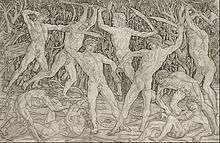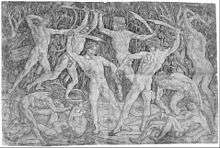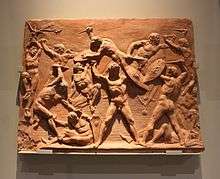Battle of the Nudes (engraving)
The Battle of the Nudes or Battle of the Naked Men,[1] probably dating from 1465–1475, is an engraving by the Florentine goldsmith and sculptor Antonio del Pollaiuolo which is one of the most significant old master prints of the Italian Renaissance. The engraving is large at 42.4 x 60.9 cm, and depicts five men wearing headbands and five men without, fighting in pairs with weapons in front of a dense background of vegetation.
.jpg)


All the figures are posed in different strained and athletic positions, and the print is advanced for the period in this respect. The style is classicizing, although they grimace fiercely, and their musculature is strongly emphasized. The two figures nearest the front of the picture space are in essentially the same pose, seen from in front and behind, and one purpose of the print may have been to give artists poses to copy. An effective and largely original return-stroke engraving technique was employed to model the bodies, with delicate and subtle effect.
Context and reception
Vasari, who praises the engraving highly, says that Pollaiuolo made other prints, but none have survived. Given the rarity of this one, Vasari may well be right, although he was writing many decades later. Alternatively he may have been referring to a number of prints after paintings or drawings of Pollaiuolo, but now universally seen as engraved by different artists to the battle, and now mostly attributed as "School of Pollaiuolo" or similar terms.
As with Andrea Mantegna, the dominant Italian printmaker of the period, based mostly in Mantua, the suggestion has been made that Pollaiuolo may not have engraved the plate himself, but hired a specialist to work from his design. However this remains a minority view.[2] Engraving was an essential skill of the goldsmith, and Pollaiuolo's workshop produced niello engraved plaques. Estimates of the date of the engraving have varied from about 1465 to about 1489.[3] As with most famous prints of the period, a number of direct copies were made in engraving and woodcut,[4] including one by "Johannes of Frankfurt" in about 1490,[5] and it was often borrowed from and imitated, for example in a drawing probably by Raphael. It is the first print to be signed with the artist's full name (on the plaque at the left rear), as opposed to the initials or monograms used by many printmakers.[6]
The print clearly relates to the work of Mantegna, although uncertainty about the dating of the works of both artists means that the direction of influence is unclear. Mantegna made two large engravings of the Battle of the Sea-Gods, and he or his followers produced a number of others of male nudes fighting under various classical titles. Despite the usual attempts by art historians, including in this case Erwin Panofsky, to identify a specific subject for the engraving, it is likely none was intended.[7] The two central figures grasp the ends of a large chain, which may suggest that the figures are to be seen as gladiators.[8]
Vasari wrote of Pollaiuolo:
He had a more modern grasp of the nude than the masters who preceded him, and he dissected many bodies to study their anatomy; and he was the first to demonstrate the method of searching out the muscles, in order that they might have their due form and place in his figures; and of those ... he engraved a battle.
On the other hand, it has been suggested that Leonardo da Vinci may have had Pollaiuolo partly in mind when he wrote that artists should not:
make their nudes wooden and without grace, so that they seem to look like a sack of nuts rather than the surface of a human being, or indeed a bundle of radishes rather than muscular nudes[9]
A recent paper suggests that the image depicts a duel between two noblemen that has degenerated into a more widespread confrontation involving the lower classes.[10] It is further posited that Pollaiuolo's contemporaries would have recognised a difference in social class among combatants based on differences in armour, weapons and actions. These and other signifiers can be traced to a literary source, Giovanni da Legnano's legal treatise Tractatus de bello, de represaliis et de duello from the late fourteenth century. [11]
States

Like most 15th-century prints, the Battle is rare. The unique first-state impression in the print room of the Cleveland Museum of Art is generally accepted as much the finest,[12] and about forty-nine impressions (single examples) survive of the second state,[13] which is actually a high number for a 15th-century print. For the period, the print is very large, which has probably contributed to the small number of surviving impressions — it is clear from the worn state of the plate in many impressions that large numbers, probably running into the hundreds, were printed of the second state. There are no significant differences between the two states, so the plate was probably reworked just because it had worn out from the printing of now lost first-state impressions.[14]
The existence of the first state was only realized in 1967, after Cleveland bought their print from the Liechtenstein collection. The best impression of the second state is in the Fogg Art Museum at Harvard; it appears to be the only one printed before the plate received a scratch, and from the paper and watermark would appear to have been printed close in time to the Cleveland impression.[15] The two woodcut copies can be shown to have been copied from the first state.[16]
Date

Although most art historians have dated the work to the period 1465–1475, in 1984 the suggestion was made that the print draws directly from a Roman sculpture known to have been excavated in Rome in 1489, Three Satyrs strangled by a Serpent (now Graz, Austria). Pollaiuolo was in Rome from 1484, and this would mean the print was executed there. This suggestion remains the subject of debate.[17]
Surviving impressions
There are fifty impressions known to have survived to 1939; their distribution gives an interesting insight into the spread of top-class old master prints. As at the census in Langdale in 2002, there are sixteen in the United States, all apparently arrived since 1890, and mostly during the period 1930–1960. Italy has nine impressions, England five, and Paris three. There were five in Germany in 1939, of which one seems definitely to have been destroyed during World War II, one other "lost" from Bremen, and one lost sight of after the war. The other impressions outside Europe are in Melbourne and Ottawa; in Europe the Albertina in Vienna, the Netherlands (3), Strasbourg (1) and Budapest have impressions. Two of the three impressions in Switzerland are the only ones in the world still in private collections.[18]
Notes
- And other variants
- See Zucker:16
- Langdale:51
- Illus Langdale:6,7
- British Museum Johannes of Frankfurt copy]
- Langdale:36 - if from 1489 it is not quite the first.
- The fullest account is in Levinson:66-71. See also Langdale:35, and Zucker:16
- As suggested by Colin Eisler — Levinson:68-70. See also Zucker:16
- Zucker:15, from which both translated quotations. (Leonardo Trans. Martin Kemp)
- Ángel Arribas Gómez, "Pollaiuolo's Battle of the Nudes as a Duel", Print Quarterly, Vol. XXXIV No.4, pp. 418-21
- Giovanni de Legnano, 'Tractatus de bello, de represaliis et de duello', edited by T. E. Holland, Oxford, 1917, pp. 331-50, in particular 349-50
- Cleveland
- Langdale:26, 71-83. See below.
- Langdale:33-4
- Langdale:34
- Langdale:32
- Zucker:15-16
- Langdale:26, 71-83. 46 impressions are catalogued and described in detail in an Appendix. All 50 are listed on p. 83.
References
| Wikimedia Commons has media related to Battle of the Naked by Antonio del Pollaiolo. |
- Cleveland Museum of Art Very full Cleveland feature on the print accessed 14 June 2014.
- Langdale, Shelley, Battle of the Nudes: Pollaiuolo's Renaissance Masterpiece, The Cleveland Museum of Art, 2002.
- Levinson; Laurie Smith Fusco in Jay A. Levinson (ed.) Early Italian Engravings from the National Gallery of Art, pp. 66–80, National Gallery of Art, Washington (Catalogue), 1973,LOC 7379624
- Metropolitan Museum of Art, New York: "Antonio Pollaiuolo: Battle of Naked Men (17.50.99)". In Timeline of Art History. 2000–8. (October 2006)
- Zucker, MJ, in KL Spangeberg (ed), Six Centuries of Master Prints, Cincinnati Art Museum, 1993, no 16,ISBN 0-931537-15-0
.jpg)